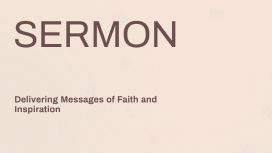SERMON
Transcript: SERMON a Historical Significance Sermons have played a pivotal role in various historical contexts, from early Christian gatherings to the Reformation and beyond. They were instrumental in shaping societal values and unifying congregations during religious movements. Definition of a Sermon A sermon is a formal discourse delivered by a religious leader, intended to convey biblical teachings and spiritual inspiration. It often addresses specific themes or topics relevant to the audience's faith journey. Community Building Types of Sermons Delivering Messages of Faith and Inspiration Sermons foster a sense of belonging and strengthen community ties among congregants. By addressing shared values and challenges, they create a supportive environment where individuals feel connected and valued. b Sermons vary widely in style and purpose, including expository, topical, devotional, and narrative formats. Each type serves distinct purposes, allowing preachers to address diverse audience needs and spiritual objectives. Teaching Moral Values Introduction to Sermons Through sermons, moral values are not only discussed but instilled within the audience. They serve as a platform to explore ethical dilemmas and encourage individuals to embody principles such as compassion, integrity, and justice. Sermons serve as vital instruments of communication within faith communities, conveying messages of spiritual importance and guidance. They have evolved over centuries, reflecting cultural shifts and theological developments. Spiritual Guidance Sermons play a crucial role in offering spiritual guidance, providing individuals with direction based on religious teachings. They encourage personal reflection and foster a deeper connection with faith, helping congregants navigate life’s challenges. The Purpose of a Sermon Sermons serve multiple vital purposes in spiritual life, ranging from providing guidance and fostering community to instilling moral values. Understanding these aspects can enrich both the speaker's delivery and the audience's reception. d Body Language and Voice Modulation c Effective use of body language and voice modulation can significantly impact the delivery of a sermon. Non-verbal cues, like gestures and facial expressions, along with variations in tone and pace, help to convey emotions and emphasize important points. Use of Visual Aids Opening: Attention Grabbers Structure of a Sermon Effective sermons begin with attention-grabbing openings that capture the audience's interest. Anecdotes, quotes, or thought-provoking questions can draw listeners in, setting the tone for the message ahead. An engaging start is crucial for fostering a connection between the speaker and the audience. Incorporating visual aids, such as slides or props, reinforces key messages and keeps the audience visually engaged. Visual elements complement spoken words and can illustrate complex ideas succinctly, enhancing understanding and retention of information. A well-structured sermon encompasses three essential components: an engaging opening to captivate attention, a substantive main body to convey key messages, and a compelling conclusion that prompts action. This framework helps ensure the sermon resonates with the audience and fulfills its purpose. Conclusion: Call to Action Engaging Storytelling The conclusion serves as a powerful call to action, urging the audience to reflect on the sermon and implement its teachings in their lives. A memorable closing statement can reinforce the key messages, leaving a lasting impact that encourages spiritual growth and community engagement. Techniques for Effective Delivery Storytelling captivates audiences by transforming abstract concepts into relatable narratives. It fosters emotional connections, allowing listeners to identify with situations and characters, ultimately enhancing understanding and retention of the sermon’s message. Effective delivery techniques enhance audience engagement during sermons, ensuring that messages resonate deeply. Employing storytelling, visual aids, and body language strengthens the emotional and intellectual connection between the speaker and the congregation. Main Body: Key Messages The core of the sermon is the main body, where key messages are developed. Each point should be supported by scripture, personal stories, or real-life examples to illustrate the importance of the message. This section is designed to educate and inspire, encouraging deeper understanding and reflection. Strengthening Faith e Sermons serve as a tool for reinforcing faith among believers. They can clarify theological concepts and provide reassurance, ultimately encouraging individuals to deepen their spiritual commitment and trust in a higher power. Behavioral Change Effective sermons can lead to observable changes in behavior among congregants. These changes may include increased community service involvement, improved interpersonal relationships, and stronger moral adherence. Impact of

















